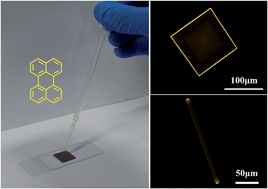Perylene crystals: tuning optoelectronic properties by dimensional-controlled synthesis†
Abstract
One-dimensional (1D) ribbon-like and two-dimensional (2D) square-like perylene crystals were prepared in a controlled manner via a simple drop-casting solution method by changing the temperature and concentration of the solution. Based on SAED and XRD results, both the ribbon and square perylene crystals belong to the α phase. From further optical and electronic characterizations, we find that perylene crystals show unique dimension-dependent optoelectronic properties. In 2D crystal, photons propagate along the two edge directions without anisotropy, indicating that the optical waveguide property may not be related to molecular packing. Propagation of photons along the direction of the axis in the 1D crystal seems to be a little more efficient than that in the 2D structure. Moreover, hole mobility of the 1D crystal is the same as that along the [001] direction of the 2D square sheet, while hole carriers are transported along the two directions of square sheet with an anisotropy about 2.3. This excellent example shows that the optical waveguide and field-effect mobility of an organic crystal can be tuned by controlling the number of dimensions of the crystal during the synthesis.


 Please wait while we load your content...
Please wait while we load your content...